#This is like introducing an invasive specie to a new ecosystem...
Explore tagged Tumblr posts
Text
A few years ago, it was hoped that this attritional warfare could be surpassed by a sort of super weapon in the form of genetic modification. A new type of chestnut, with a wheat gene inserted into its genetic makeup, showed remarkably favorable signs of survival in the lab but then floundered when planted in the field.
The chestnut foundation cut support for the project, called Darling 58, in 2023.
NEVER GIVE UP.
Project leaders are aiming for 1,000 chestnuts in New York but have to content themselves with a smaller initial number due to a constrained availability of seeds, garnered from plantings by the American Chestnut Foundation and also from the 230 or so chestnuts that remain scattered in New York itself. The saplings grown from this group are huddled in pots in a fenced-off area in Manhattan and will soon be distributed to successful applicants.
About half of New York’s surviving chestnuts are found in a promising initiative that has taken root in Highbridge Park, a strip of woodland in the upper reaches of Manhattan that slopes down towards the Harlem river.
The New York Restoration Project started work here in the 1990s, a time when the area was a derelict dumping ground for car parts. In typical New York fashion the task of coaxing back an ecosystem has faced a myriad of unusual challenges – from battling invasive knotweed to dealing with a homeless encampment and even a group of resident nudists.
“There has always been something to keep us busy,” said Smith. His group has installed rain gardens, to help stem the flooding risk from the nearby river, removed debris and is in the process of installing a new path to allow locals to enjoy the revitalized park again. On a recent warm spring day, a single rusting car engine sat, like a museum piece, amid a verdant throng of ash, sycamore and sugar maple. Spores from cottonwoods covered the ground like a downy blanket.
The crowing glory of this space, though, is its American chestnuts, planted in 2017 to stunning success. “We didn’t know what was going to happen but this tree here is probably like 35ft tall now,” said Smith, pointing to a chestnut that pierced the thin canopy. The blight still might take hold here but there has been remarkable resilience so far with just two of the more than 120 trees – which are hybrids with a Chinese chestnut variant but still genetically 95% American – struck down by the disease.
The American chestnut was once found in vast numbers from Maine to Mississippi and known as the redwood of the east due to its prodigious size. But 4bn trees were killed off in the first half of last century by a blight introduced from Asia to which it had little defense, spread by spores carried by the wind, rain and animals.
The blight, Cryphonectria parasitica, first spotted in 1904 on trees at New York’s Bronx Zoo, causes necrotic lesions on the chestnut’s bark as it cuts off the tree’s access to water and nutrients until it dies above ground.
Some chestnut roots and shoots remain today, but very few trees reach their full imposing extent, of about 100ft in height and 8ft wide at the base. Decades of scientific and charitable work has sought to resurrect the chestnut, with varying results, and now a new project is turning to the citizens of New York to help restore the species to something of its former glory.
“You can use the wood for anything, it’s a cradle-to-grave tree because you can use it for cradles or coffins, you can fatten your hogs on the nuts,” she said. “I’ve heard it referred to as charismatic mega flora – people are just drawn to it. We have had the ecological tragedy of losing it but it’s also a cultural tragedy. We want to restore those cultural connections.”
This restoration could take decades, though. “We should think of it as a cathedral-building undertaking that will maybe not be complete in our lifetime,” as Smith put it.
But at a time when the de-extinction of lost species, such as the woolly mammoth or dire wolf, is in vogue in an attention-grabbing way, the return of the chestnut has a more pragmatic rationale, its proponents argue.
The tree can soak up vast quantities of carbon, vital amid the climate crisis, and fulfills all of the same roles for insects and birds even if it is crossed with a Chinese or Japanese variant.
“This isn’t a gimmick, we are thinking about the ecological function of the tree,” said Smith. “At a time when we are losing so much of our forests, we can’t be purist about bringing back the most important tree in the north-east. We usually aim really low for conservation efforts in urban spaces, and we don’t have to.”

Next week, I graduate with my BFA in Art. This was my final piece of Illustration coursework. Hoping that it'll be part of the pitch package for a real book before long. 😊
Billions of Mouths to Feed Like most birds, the passenger pigeon was omnivorous, feeding on a wide variety of plant and insect matter. The most important of its food sources were mast-producing trees. A single pigeon could eat half its body weight in a day, and flocks wandered thousands of miles in search of a bountiful harvest; it was this habit of travel that gave the bird its name. Pigeons showed a preference for the mast of the American beech, the white oak, and the American chestnut (a tree whose own catastrophic population collapse, resulting from imported disease, may have played a role in the concurrent decline of the pigeon).
336 notes
·
View notes
Text
Aaaaaand I'm done! Out of all the characters that appeared in this tournament, 186 ended being a YES for the criteria of the Loser Edition, 88 were a no and 73 were a maybe which surprised me. But really it shouldn't have, half of the contestants get ditched on the first round.
I added the YES and Maybes together and removed 3 characters that don't really fit anymore my criteria of participation and here we have 256 contestants ready for the Loser Edition! So look forward to it!
#Since I added the Maybes that means that yes 707 and Astarion are in it#This is like introducing an invasive specie to a new ecosystem...#I thought it would take me like 2 hours but damn I started at 11am and it's 7pm now#Don't make tournament blogs people#It's bad for your health#not a poll
19 notes
·
View notes
Text
The idea of Pleistocene rewilding, even though it annoys the hell out of me, is so interesting in what it implies about ecosystems.
If we accept that North America's ecosystems are "incomplete" or "impoverished" because of the extinction of Pleistocene megafauna, that implies there is a "complete" state of ecosystems. In the absolute sense, of course ecosystems don't ever have a "complete" state, but is it possible for an ecosystem to be relatively incomplete? What does that even mean?
Could an "incomplete" state of an ecosystem be recognizable without knowing what used to exist in that ecosystem, for comparison? Could a researcher tell that they were in an environment where an animal had gone extinct, without any direct evidence of that animal or knowledge of what it was? Who is to say how many taxa of a kind of creatures "should" be in the ecosystem?
Say we accept, then, that North America's ecosystems after the Pleistocene (but before European colonization, which involved intentional destruction) were "complete," in the sense that researchers couldn't detect any obvious "dysfunction," whatever that means.
But 10,000 years, compared with life's history on the earth, are nothing--- the blink of an eye. There hasn't been very much time for entirely new types of animals to evolve.
So it would imply that ecosystems have a LOT of plasticity and ability to re-arrange to absorb shock, and that animals can quickly expand their ranges and change their niches to adapt to the new state of existence.
...this, in turn, implies something strange about the introduction of new animal species to a continental mainland: that "native" and "non-native" animal species probably won't be distinguishably different in their impacts in the long term, because the ecosystem is chaotic and constantly changing to begin with.
Introducing new animals to islands is a disaster, because it's introducing an animal with a niche that didn't exist before at all, such as terrestrial predators or large herbivores. Introducing plants is a disaster in a small and unpredictable sample of cases.
But in the example of horses in North America, the impact could range from positive (horses used to be here, and their extinction "damaged the ecosystem," therefore horses being introduced "fixes" that damage) to neutral (the ecosystem adapted to not having horses very fast, therefore the ecosystem can likely adapt to having horses again very fast). Saying that horses are invasive seems to require us to believe contradictory things: that the ecosystem has changed so much since the Pleistocene that horses no longer belong, and that ecosystems can't adjust to change quickly.
Then, why indeed should we not introduce camels, or cheetahs, or lions?
Well, this is where "Pleistocene rewilding" gets on my nerves: it sees North America as fundamentally impoverished of animals, and at the same time, somehow treats different species of animal as weirdly interchangeable. We don't know if the American lion was closer to a lion or a tiger, and we don't know some important things like its hunting behavior. The "American cheetah" was not any more closely related to the African cheetah than to the cougar, and might not have been a specialized fast runner like the cheetah.
So this might apply to the horse just as well: the species of horse in Pleistocene times might have been so different from today's horse that they don't have the same role in the ecosystem. Well, is it better to be horseless or horsed?
I don't think that introduced species are inherently bad. This isn't a extreme position. Among plants, very few introduced species actually become invasive, and even some of those considered "invasive" are not actually harming the ecosystem in a way that can be demonstrated. I don't think I would recommend the introduction of a plant purposefully, though...or would I? With climate change occurring rapidly, I am in favor of moving species to areas where they can survive.
One philosophy of biodiversity is that the more biodiverse the ecosystem, the more ability the ecosystem has to absorb shock and adapt to change. Introduced species could have a range of potential to adapt different from native species, and could raise the shock absorption potential of an ecosystem. But they would also disrupt existing relationships and cause a shock to the native species that already exist.
Range expansions are an alternative to extinction for some species. We will probably HAVE to consider introducing species to new areas in the future. Well, imagine in the future we put Zebras in Arkansas, and the Zebras outcompeted the white-tailed deer in that area. Is that good or bad? Both species get to keep existing, but the deer's range is a bit smaller. Is the measure of biodiversity more important in a local area or in the world?
Makes my head hurt...
1K notes
·
View notes
Text
This ties into one of the big conundrums of restoration ecology. When trying to decide what plants to add to a restoration site, should we add those that are there now, even if some of those species are increasingly stressed by the effects of climate change? Or do we start importing native species in adjacent ecoregions that are more tolerant of heat?
Animals can migrate relatively quickly, but plants take longer to expand their range, and the animals that they have mutual relationships with may be moving to cooler areas faster than the plants can follow. Whether the animals will be able to survive in their new range without their plant partners is another question, and that is an argument in favor of trying to help the plants keep up with them. We're not just having to think about what effects climate change will have next summer, but also predict what it's going to look like here in fifty years, a hundred, or beyond. It's an especially important question in regards to slow-growing trees which may not reproduce until they are several years old, and which can take decades to really be a significant support of their local ecosystem.
For example, here in the Pacific Northwest west of the Cascades, western red cedar (Thuja plicata) is experiencing increased die-off due to longer, hotter summer droughts. Do we continue to plant western red cedar, in the hopes that some of them may display greater tolerance to drought and heat? Or do we instead plant Port Orford cedar (Chamaecyparis lawsoniana), which is found in red cedar's southern range, and which may be more drought-tolerant, even though it's not found this far north yet?
Planting something from an adjacent ecoregion isn't the same as grabbing a plant from halfway around the world and establishing it as an invasive species. But there is the question as to whether the established native would have been able to survive if we hadn't introduced a competing "neighbor" species. Would the Port Orford cedars and western red cedars be able to coexist as they do in northern California and southern Oregon, or would the introduced Port Orfords be enough to push the already stressed red cedars over the edge to extirpation?
There's no simple answer. But I am glad to see the government at least allowing some leeway for those ecologists who are desperately trying any tactic they can to save rare species from extinction.
#restoration ecology#ecology#habitat restoration#climate change#global warming#anthropogenic climate change#nature#wildlife#plants#botany#trees#endangered species#extinction#environment#conservation#environmentalism#science#scicomm#science communication
2K notes
·
View notes
Text
Biggest galaxy brain moment from visiting the Dune dunes is that it gave me a whole new perspective on why the terraforming of Arrakis is treated with such deep ambivalence by the text. Because the terraforming process that's described in great detail in the book? That's exactly what's happening to the Oregon dunes. And they're disappearing.

At the beginning of the 20th century, the open sand you see in this picture stretched all the way to the Pacific Ocean, which is visible here as a faint blue-gray line about halfway up the photo. The sea washed new sand ashore, and the seasonal wind cycles blew it into a constantly-shifting landscape of dunes, tree islands, ghost forests and both permanent and ephemeral lakes and rivers.
As European colonization of the Pacific Northwest grew, the new settlers and the logging and commercial fishing industries they brought with them wanted permanent towns and roads that weren't constantly being swallowed by the moving sand. Starting in the 1930s, European beachgrass and other non-native species were introduced to try to hold the dunes in place.
The invasive species did hold the dunes in place--too well. The deep roots of the beachgrass shaped the sand blowing in off the beach into a permanent dune parallel to the ocean, called the foredune.

As the foredune got taller, it blocked both wind and the movement of sand, which allowed the land behind it to become grassland...

then forest.

Walking through this area, you might never know there was a dune under your feet. You can be close enough to hear the ocean, but there is almost NO wind--the main force that shapes the dunes.
There are (slow, difficult) remediation efforts underway to control the European beachgrass and restore at least some of the area to the natural dune cycle that created the miles and miles of open sand. But the ecological feedback loop created by introducing the beachgrass is stubborn, and without any further intervention, the dunes could be completely covered with forest in as little as a few decades. (I've heard estimates from 50 to 150 years, both of which are a blink of an eye in geological timescales.) The Oregon dunes are at least 100,000 years old, and within the span of just a few human lifetimes the ecosystem could be irrevocably changed.
The dune stabilization project is what Frank Herbert came to Florence to research for a never-written magazine article. Herbert began writing Dune in the mid-1950s, but by the mid-60s when the book was published, his own politics had shifted as he was influenced by the growing environmental movement and by Native activism happening around him in the Pacific Northwest. Like the story of the Oregon dunes, the terraforming of Arrakis is initially promoted as triumph of science and human rationality over nature that will make people's lives easier. But it ends up destroying the native ecosystem and the way of life of the planet's indigenous people, as becomes clear in Dune Messiah when Paul actually implements the terraforming project. (In the book, Dr. Kynes, the main architect of the terraforming project, dies in a spice blow--literally swallowed whole by the planet he tried to control.) It's one of the many political/ideological tensions in the story that's presented but not resolved, and I'm super curious to see how this element of the story is handled in Villeneuve's Dune Messiah.
All photos above taken by me at the Oregon Dunes National Recreation Area in September 2024.
152 notes
·
View notes
Text
Do you ever think about how 1977's Araiguma Rascal (Rascal the Raccoon) influenced Japan's perception of raccoons? And how that possibly ties in to Marine the Raccoon from the Sonic franchise?
no? okay. so let me explain
So Araiguma Rascal was 1977's entry into Nippon Animation's line of "World Masterpiece Theater" anime. World Masterpiece Theater was a popular timeslot dedicated to an adaptation of a famous novel or short story. Rascal is based on 1963 autographical book by Sterling North. It essentially tells the tale of a boy and him fostering an abandoned raccoon and it becoming his pet.
youtube
It should be noted that Japan up until 1977 had close to 0 raccoons in it. It is not a native species to Japan. However, viewers became very charmed by Rascal and wild raccoons started being imported to Japanese homes with the intention of keeping them as pets.
The ending of Araiguma Rascal (the anime anyway, I'm not familiar with the book and how it compares) has Sterling releasing Rascal into the wild. So many Japanese viewers who had buyers remorse with an actual wild animal in their home - did the same. And raccoons in Japan are to this day an invasive species. You can read about it more here
You might be asking "MajoBun what the hell does this have to do with Sonic?" - so even though Araiguma Rascal messed up the ecosystem, Rascal remains an incredibly popular mascot for Nippon Animation and a representative of the "World Masterpiece Theater" brand.
Over the years though they've made him more...hm. Mascot-like
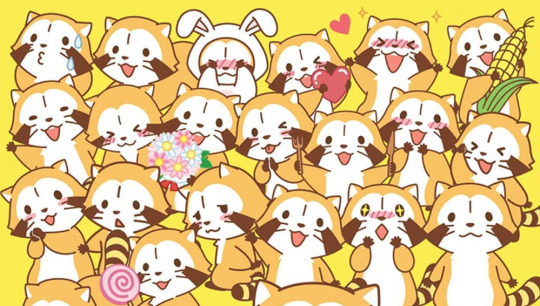
Complete with a new brighter and eyecatching color scheme, the brighter orange and brown palette seems to have started around 2000 from what I could find.
You may have seen some of your favorite anime do collaborations with Rascal actually!
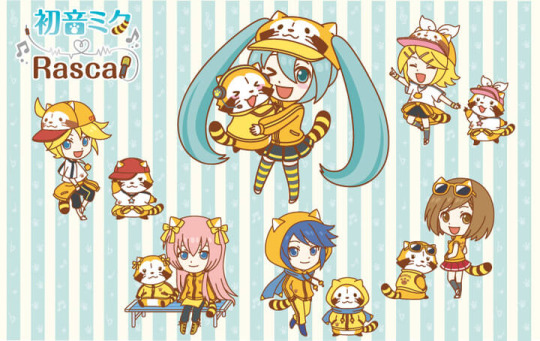
So unless you know a lot about animals or have to deal with the invasive raccoons eating the infrastructure to your home, it's possible that Rascal the mascot raccoon is the only raccoon you know.
Enter Marine the Raccoon, introduced to Sonic Rush Adventure in 2007. And hey, guest what color she is

(hint: she's orange and brown) Of course this is huge speculation on my part because Sega and her designer have never stated their influence to her design. Also, it's sonic. it's built on bright snappy color schemes for it's characters.
But still, whenever I see people think she's a red panda or think she should be more grey or something, I think it's worth noting that if the most popular raccoon in Japanese pop culture is orange, you bet Sega's gonna try to imitate what works.
Anyway, this is was really a big excuse to talk about Rascal the Raccoon. I think it's impact is incredibly interesting.
144 notes
·
View notes
Note
are mustangs a native or invasive species? do you think they should be rounded up?
I think it would be overly conclusory to say either at this point. As far as I know, there haven't been any radio carboned equine remains that show they survived through the ice age in North America. There is some evidence that shows they survived later than what was originally thought though, and were also in the West before the Pueblo Rebellion, which was when many white people thought they were introduced there.
But if they are not native, it would be a mistake to automatically conclude that they are invasive because there is also a lot of new evidence that shows that they are ecosystem engineers. "Invasive" implies a species that causes ecological harm to a new area, but several studies done on wild horses and burros in the Western US show some positive impacts. The ones that I know of are:
Equids engineer desert water availability - this study was done in the Sonoran desert in AZ and showed that equine dug wells increased biodiversity in the surrounding areas by 64%, and often were the only water sources. The researchers concluded "that equids, even those that are introduced or feral, are able to buffer water availability, which may increase resilience to ongoing human-caused aridification.”
Impact Of Wild Horses On Wilderness Landscape And Wildfire - this was done in Northern California to push back on claims made by the BLM that wild horses had a negative impact on the ecosystem and had no predators. It found that horses degraded land less than some of the even-toed ungulates because their hooves are not sharp and pointed like theirs. The riparian ecosystems in the area of study were not permanently damaged by horses because predators prevented them from staying long, and their predators included coyotes, mountain lions, and bears for foals, and bears and mountain lions for adults. Additionally, by eating dry grass the horses reduced the fuel load in the area, and likely prevented a branch that fell and ignited after being hit by lightening from causing a wildfire.
A roundup in the Ash Meadows Reserve in Nevada caused a population of critically endangered pupfish to go extinct - this was cited by the first study mentioned. Once the equines were removed from the area, the riparian habitat became choked by vegetation, a whole population of pupfish died as a result.
To me what these studies suggest is that native or not, the mustangs and burros are filling a distinct role that was not taken on by another native species if their ancestors did go extinct. I don't think the BLM has properly taken this into account in their Appropriate Management Level assessments, though courts tend to give them so much deference as a federal agency that I don't think any have found that they actually violated National Environmental Policy Act. Under NEPA, the BLM is supposed to consider all reasonable alternatives when making environmental impact statement and assessment proposals. I think these studies show that livestock reduction and predator re-introduction should be considered as reasonable alternatives before roundups given the immense cost of roundups and lack of permanent improvement of the range after them, but the BLM has given reasons not to try these options such as "the horses don't have predators in this area" or " it doesn't conform to the current multiple use land management plans." The courts usually accept these reasons as valid. See Friends of Animals v. Silvey.
39 notes
·
View notes
Text
If you don't already follow bplant.org, I highly recommend it! It's a great database to see which species are native in your area, and they're doing really incredible work.
Here are some highlights from the article:
---
How has the ornamental plant industry caused harm?
An overwhelming majority of the worst invasive plants in North America were intentionally introduced as landscaping plants. Our analysis of the 96 species on the Delaware Invasive Species Council's Invasive Plant List found that 67 of them, about 70%, originated as ornamental or landscaping plants, and only 7 of these ornamentals also had other uses such as food or fodder. Ornamentals (70%) are a much greater source of invasive introduction than other sources, such as accidental introduction (22%), food plants (11%), or other intentional uses (7%). (These figures add to more than 100% because some plants had multiple paths of introduction.)
[...]
The breeding likely contributed to these plants' invasiveness. The horticulture industry tends to select for traits such as climate hardiness, insect resistance, ease of propagation, and ability to survive in a range of conditions with little care. The selection for insect resistance increases the likelihood both that a plant will have a competitive advantage in the wild, and that it will lead to food web collapse if it does become invasive. The other traits contribute to invasiveness by increasing a plant's fitness in a new region.
Furthermore, when developing cultivars, horticulturalists often cross-breed plants from different sources throughout the plant's native range in order to access a greater pool of genetic diversity to work with. This process alone often increases the plant's vigor and thus its potential to become invasive.
[...]
Horticulture develops, promote, and sells plants with little to no regard for the unique habitat preferences of particular plants.
[...]
Not only does this phenomenon lead to stunted plants, it drives a lot of resource usage as people pour money and effort into irrigation, soil enrichment, or even importing new soil. In the West, such wasteful water usage worsens already-severe problems like depleted aquifers or the fact that the U.S. has used up nearly all the water in the Colorado River before it reaches its delta, which has devastated the delta's ecosystems and also devastated the fishing industry in the Gulf of California. Stressed plants growing on unsuitable sites can also create costly accidents, especially with trees, which can fall on buildings, vehicles, or even injure people.
[...]
Many of these lineages have been isolated from wild populations for generations now, and selected for traits such as insect resistance and propagation in a nursery setting. Even Mt. Cuba Center, often hailed as a leader in the native plant movement, suffers from this approach. Although Mt. Cuba makes sure their plants provide value to the food web through functioning as insect food, their trial garden still tests plants only in a typical garden setting, meaning a mulch bed in more-or-less mesic conditions (moist and well-drained.) Plants adapted to other conditions are given a lower score if they perform poorly in test plots, even if they thrive in the more naturalistic gardens elsewhere on the grounds. Plant breeders are often selecting for similar characteristics, and thus may breed out the traits that make plants adapted to their unique habitat in the wild. When people buy and plant nursery-grown plants, whether in their yards or gardens, or in ecological restoration projects, they are adding genetics which have three features:
The source population(s) are unknown.
Multiple source populations, perhaps far apart, may have been interbred to produce the line.
The plants have been selected, often over many generations, for horticultural attributes.
[...]
What can you do to encourage the necessary change?
If you are only a customer of the nursery industry, whether as an individual, or a large-scale buyer, probably the most important thing you can do to stop buying into nurseries that are far from following best practices on these matters. Do not buy any non-native ornamental plants. If you have not already done so, sign and share the petition to stop Home Depot from selling invasive plants, and support state-level efforts to restrict or ban the sale of invasive plants.
I would go farther, however, and recommend to avoid purchasing any plants that are not derived from local, wild populations. The nursery industry is not going to change just because a minority of people tell them to; they will change when the economics force them to. When you buy plants, even native plants, whose origins are unknown, you support the status quo. And the status quo is a lose-lose. The wholesale nursery industry mass-produces plants of unknown origin, mass-markets them, and most of them get shipped over long distances only to get sold mostly at box retailers where the jobs selling them are low-skill and low-pay. The plants themselves are often unhealthy, and can sometimes pose ecological problems when planted.
---
The article is very in-depth, and even discusses alternate business models for nurseries that could help to address these issues.
12 notes
·
View notes
Note
I am a very normal person who gave her real life cats warrior names, and now I am being a very normal person who spends her lunch break translating them into Clanmew:
Owlberry: Huobayab. Huo (eagle owl) + bayab (blackberry/brambles). She’s a big, fluffy, mostly dark brown cat who is motherly and protective but can definitely be very prickly, so I think it fits well. Her real name is Cheesecake.
Batwhisker: Fepfr’hussk. Fepfr (long eared brown bat) + hussk (whisker). The first thing I said upon seeing him, an eight week old bundle of rage, was “Oh my GOD his EARS” so I love this. He’s a tuxedo with big ears and BIG whiskers. His real name is Junior Bacon Cheeseburger. Fun fact: nothing is legally stopping you from naming a cat Junior Bacon Cheeseburger.
Poppyfang: Liafiki. Liafi (poppy) + ki (fang). She’s a calico and her real name is Poptart. This sounds very dainty and pretty which is very accurate to the real cat.
Turtlecloud: this is where I need help; is there a Clanmew word for Turtle yet? Google tells me they’re not native to Britain which genuinely surprised me. Of the introduced species I found on Wikipedia, she vaguely resembles the European pond turtle, she’s a dark tortie with a few specks of very bright orange. Her suffix will be -hai (fat cloud) because good lord she is a fat little cloud. Her real name is Ginger, and she is Poptart’s wikffra.
Hazelsnap: Her prefix was originally meant to reference hazelnuts, but after searching the spreadsheet I love Geehees- (hazel slender moth) for her, because it looks pointy and weird, and the real cat was the pointiest and weirdest animal I ever met, plus she was very small and flighty like a moth. I referenced my silly nickname for her, based on the noise she used to make, to invent the word “grecc”— the “ekh” noise cats make when you startle them, the Activation Noise, a sudden surprise. Geehees’grecc. Her real name was Hazel Grace/Grecc and she has since gone to walk in Starclan, and is squinting at me judgmentally even as I type.
It is such a shame that mainline WC doesn't do more with the idea of a cat carrying multiple names, unironically they should have taken inspiration from Cats: The Musical for that. You are doing the lord's work by sharing the kittypet names, love it
I'll give you two new words plus related terms, just to get a Clanmew phrase for hazel trees out there, though I'd absolutely keep Hazelsnap's prefix as Geehees because that's perfect.
Turtle = Ooba
Turtles are an invasive species in the UK, you're correct! They are released as a product of the pet trade, where they can wreak havoc on water ecosystems. They tend to like ponds and lakes more than rivers, though.
So it's usually ShadowClan that's encountering them, and they have a FAVORITE use for the little guys... their shells make perfect soup bowls.
The word for "Turtle" and the word for "Bowl" are the same. A bowl of turtle soup is an Ooba-en-Soogwa Ooba (Bowl/Turtle-of-Soup Bowl/Turtle). Turtle shells are also valued as decorative dishes, almost like our idea of 'fine china.' It's a morbid joke in ShadowClan that the first food a bowl holds is the turtle that it used to be.
(I need to come up with some kind of phrase similar to "having your own ass handed to you" but it's "Being served in your own shell." "He made you into the bowl AND the soup")
Stumptail's daughter Turtlebelly in Clanmew is Oobaboma. Bowl-Belly.
Unfortunately for Clan cats but FORTUNATELY for the ecosystem, there aren't any turtles in the Lake territory. Not ones that breed, anyway, ShadowClan has immediately killed the 2 or 3 irresponsible releases that have occurred in the past 10 years since they've been here.
Hazel (Corylus avellana) = Ans
One of the most important trees for Clan use. It's a small, thin-wooded plant that makes the PERFECT size for harvest. It's the wood that WindClan tends to use to reinforce tunnels, it's supple and strong enough for use in building, and produces helpful "cob" nuts that can be used as a prey lure.
In BB, Hazeltail's name, her whippy tail like a hazel branch, and young wisdom were taken as a sign that she would one day be a fantastic builder. Since she's not dead in this AU she is going to be rising through the ranks there.
Most Clans don't have a particular word for Hazelnuts. They call them Nekboq Ans. ThunderClan, however, uses them as prey lures on a frequent basis. They call them Ansneb, and it is part of a 3-stem verb "to lure."
Lured/Luring/Will Lure = Ansnebok/Ansnebo/Ansneb
As a prefix in a name, Ansneb is best translated as "Cob" or "Hazelnut," but based on context can mean "alluring," "tempting," or "bait."
82 notes
·
View notes
Text










Ten-Lined June Beetle - Polyphylla decemlineata
The stripes along this Beetle's shell are very prominent, but not necessarily distinct as there are a few similar-looking species. It does make for a beautiful find from Canada's west coast (in Squamish). My dear friend found it sheltering inside his car. Presumably it needed a ride to Vancouver and public transit just wouldn't do. While I'm kidding here, insects do on occasion get transported to new locations via road vehicles or overseas shipping. Such activity can introduce species that are normally considered harmless within their native range into an ecosystem that isn't prepared for them! This can result in pest status, or being labelled an invasive specie should their habit become too detrimental. This specie is fortunately not an invasive one here, as it is native to western North America. It instead has status as a pest of orchards, whereby the adults feed on fruit tree leaves while the larvae feed on their roots! Naturally, this can warrant monitoring of crops to prevent extensive damage, especially for the larvae who may inadvertently destroy young trees during their time developing beneath the soil. Today's specimen has pupated and left that life behind in favor of a more herbivorous routine. Despite the weight of her armored shell, this Scarab is quite capable of strong flight.
For a North American comparison between similar Beetles, my friend described this insect's behavior (when he found it) as similar to that of May Beetles (Phyllophaga spp.), which are more common in my neck of the woods. Both genera seem to have a fondness for flying into lights at nighttime. There is somewhat of a resemblance as well, especially with the soft fluff on the Beetle's underside. The Ten-Lined June Beetle is far more glamorous, however. There's a lack of confirmation on this, but it's possible that those bold stripes gave this Beetle its other common name: the Watermelon Beetle. I'd be hard pressed to say that their feeding habits created that name since watermelons grow on vines rather than trees (the harvest would be much more precarious if that were the case). Finally, should you find a Beetle similar in appearance to this one, take note of its antennae. This individual is likely to be a female as her antennae is reduced in size, but it can still fan out (from a club shape) to better catch scents on the breeze. Male Ten-Lined June Beetles have enormous, (curved) paddle-like antennae jutting out from their heads! Genuinely, you can't miss them! Although particularly ornamental in design, they aren't useful as weapons to batter away rival insects. They elaborately fan out to catch the alluring scent of a female Beetle's pheromones, but I wonder how the male's flight stability and direction are affected by the larger antennae.
Pictures were taken on August 5, 2024 in Squamish with an iPhone 12.
#jonny’s insect catalogue#insect#beetle#ten lined june beetle#scarab beetle#june bug#coleoptera#watermelon beetle#squamish#sḵwx̱wú7mesh#august2024#2024#nature#entomology#invertebrates#arthropods#photography#animals
11 notes
·
View notes
Text
Sure we've put Servantverse in GUDAGUDA, but what do you think would happen if GUDAGUDA Particles were introduced to the Servantverse? Would Mini Nobbus be like an invasive species or do you think it'd be a situation where a new species gets introduced and actually fits into the ecosystem without too many problems? Or would the Nobbus not even last 5 minutes?
33 notes
·
View notes
Text
my perspective on invasive plant species has changed a lot lately
like I think current methods of dealing with invasive species are good for one thing, maintaining the existence of native ecosystems in spite of the presence of invasive species.
what they are NOT good for, is actually eradicating the invasive species, and I think we have to be upfront about the fact that it's impossible to eradicate an invasive plant across an area the size of Europe
I was thinking about the recent legislation against Bradford pears and the "Bradford pear bounties" that have been happening lately and like...we are thirty years too late.
the research shows that invasive species spend substantial time adapting to the new ecosystem before they "breach containment" and become invasive. The crucial period for stopping a species invasion is way before it becomes noticeably a problem. The existence of a single spontaneous tree popping up in a fence line or vacant lot a hundred meters from an intentionally planted tree intuitively seems to pose virtually no threat, but it indicates that the introduced species has reproduced sexually and produced an offspring that successfully lives in a less cultivated environment than its parents. Once a few different locations have instances of the non-native tree growing successfully in these marginal areas, the plant is actively working on adapting to the new habitat
Once there is a population spreading outside areas directly adjacent to planted trees, legislating against the tree in that area is as good as useless. Pandora's box is already open. The number of new trees that were intentionally planted will be such a tiny percentage of the total number in the breeding pool.
What WOULD be helpful, is legislating against the tree in areas where there isn't a feral population yet. But people won't do that because "they aren't invasive here!" They aren't invasive there yet.
It occurs to me that destroying cultivated instances, like with the Bradford pear bounty, might actually be worse than doing nothing in areas that are already overrun, because it's removing the cultivated, less fit genetics from the gene pool. In the early stages of invasion repeated backcrossing with the non-feral cultivars probably slows down the dissemination of the naturally-selected, feral genetics.
Of course, there are so many more feral Bradford pears than cultivated Bradford pears that it makes little difference, and they're being replaced with native trees, so I'm all for it.
The strongest focus for legislation needs to be on restricting introduction of new cultivars of an already introduced species, and on restricting introduction of non-native species outright.
This is unlikely to fly with the landscaping and nursery industry, and complicated by the ambiguity of "native" and "non-native."
366 notes
·
View notes
Text
This might come out a little bit late because my wrist is KILLING me but it's time for new garden update!!
I am, in fact, looking for advice for Spider Plant, African Violet, and random thing attached to my plants. This is a long post but if you are knowledgeable in any of those and would be willing to skip down to the section about those problems I would super appreciate it <3
First of all the spider plant is STILL flowering and making many new babies. I'm thinking about starting a plant section of my art business (which is usually inactive but I've been thinking of booting up again) so this is great news.
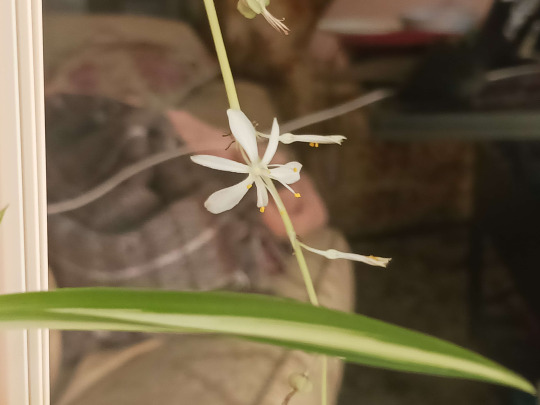
The two babies I propogated recently are doing well, for the most part. I didn't propogate them at the same time, so they are at different stages of progress. The first one went into a head-shaped pot with pebbles at the bottom for extra drainage and has found its home at the foot of my bed so that I can feel like I have some form of life in here besides Rookie sneaking in to take naps on my pillow or in my clean laundry when I'm not looking. The bedroom baby seems to have taken root, actually, judging by the fact that just now I pulled gently at it from the base and it didn't budge an inch from the soil, whereas when I first potted it it was looser than a 1900s social pariah (feminine). The leaves are also seeming to stand up straighter.
The second one however is just in a plastic container with no special drainage. The only reason I propogated it at all is because I was sitting watching My Hero Academia with my roommate and one of our friends when I looked Slightly to the right and had The Urge to Repot. I tried so hard to resist, I really did. I fought The Urge for at least 30 mins before finally, in the middle of an episode, i just stood up, went out on the balcony at 10.30 at night and propogated it without warning.
I'm pretty sure the only words I offered as explanation in the moment were "The plant was calling." I looked like a madman shoveling dirt into a cup in the middle of the night when previously I had shown zero indication that I would be leaving the couch until bedtime.
It's doing alright, the soil seems overly wet but that is probably because the plant is new enough that it hasn't yet developed the roots to drink up. I just need to give it time while I find a proper pot for it. I think I have one in my bedroom actually, I just need to paint it.

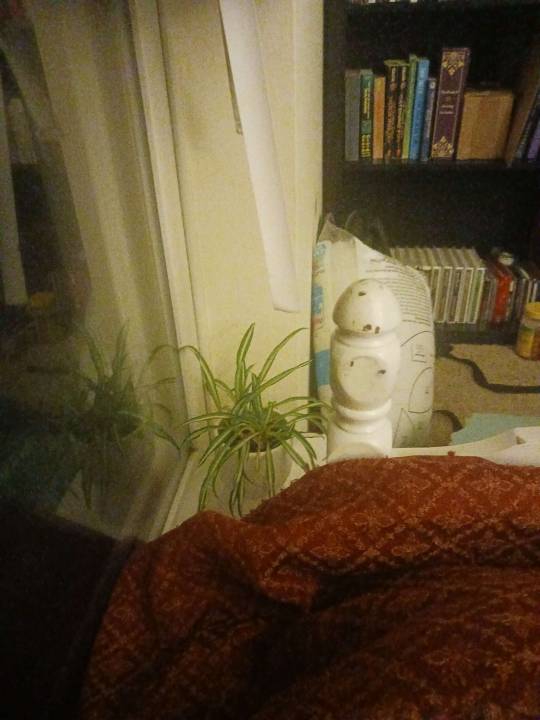
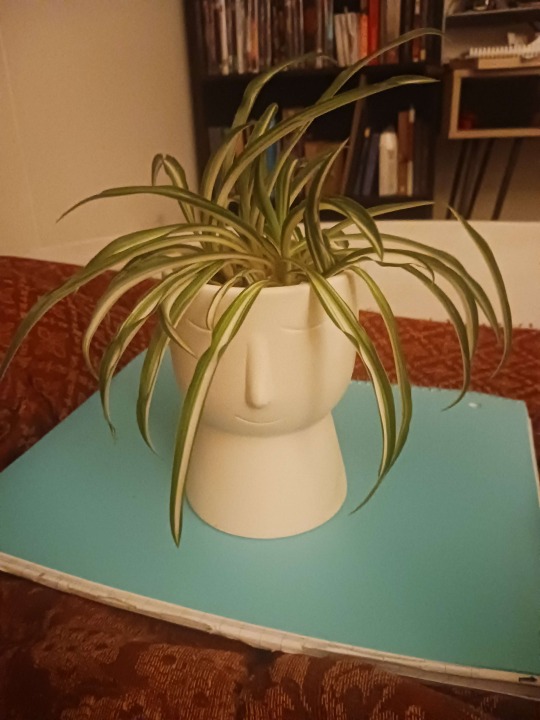
On the OTHER hand, the main spider plant is also turning brown at the ends which is kind of concerning. I don't know if it's the stem from the baby I just took off, drawing nutrients away (see blurry photo of long stem turning brown and dying) or if it's some kind of consequence of me accidentally overwatering her last week because I thought a water stake was a good idea (I'm never using water stakes again). If anyone has any insight on that, i would be thrilled to hear it. It's indoors so unless some nasty bug has gotten in, it's unlikely to be bug eating it.
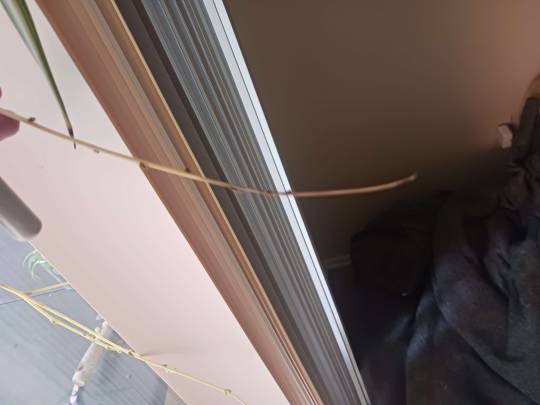
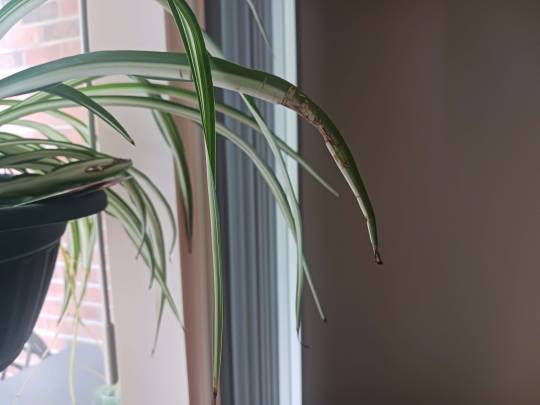
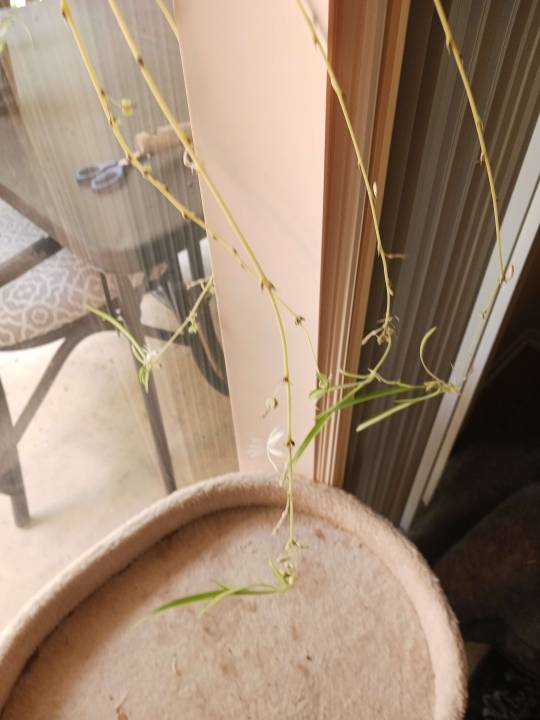
One thing that I DO know bugs are eating is my BASIL!!!!!! I don't know if you guys are familiar with spotted lanternflies, but they're super invasive here in the US and in my state are actually considered "Under Quarantine" which means that affected counties/cities are kept track of and, if you live in one, you need a permit & training course on finding and eliminating spotted lanternflies before you can sell any kind of organic matter outside of the quarantine area. They eat grapevines like mad which is threatening to VA's economy (they're all big wine people)
Their main source of food is Tree of Heaven, which coincidentally is ALSO an invasive species from Asia. Including kudzu, bamboo and asian pear trees this is 4 plants and 1 HORRIBLE little bug that are wreaking havoc on Virginia's ecosystem because of being DELIBERATELY!!! introduced as an ornamental (Decorative!) plant. (bug hitched a ride) Unbelievable.
Anyway they also like to eat basil and I have my basil outside so that it can get a sufficient amount of sun to keep from wilting all the time, so guess what I find every time I go outside! This little PECKERHEAD (or his brothers) just hanging out on my basil sitting perfectly still just like I'm his dad and I just walked into the room and he's trying to pretend he wasn't just on his phone. Anyway today I went to get some leaves for cooking and like half of them were just absolutely emacerated with brown/black spots and holes because the lanternfly nymphs have been nibbling on them. Varmints.
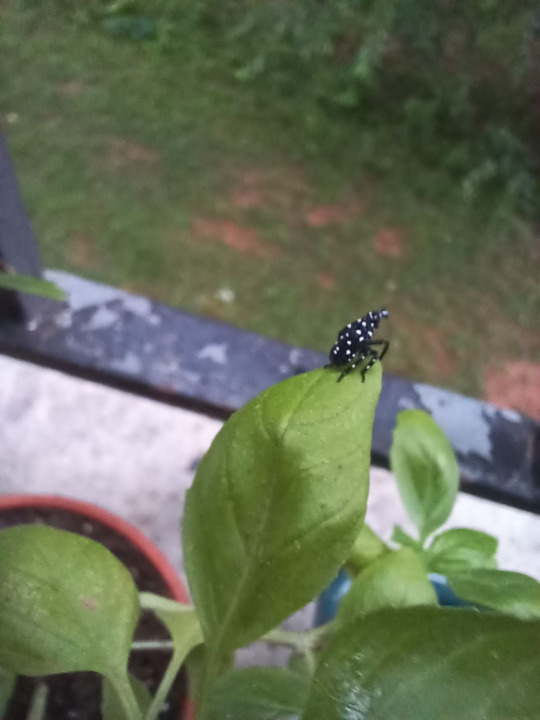
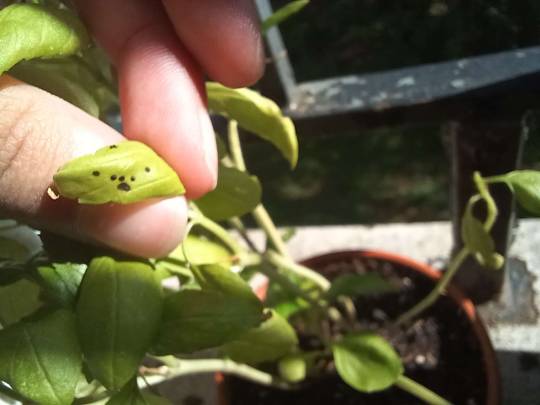
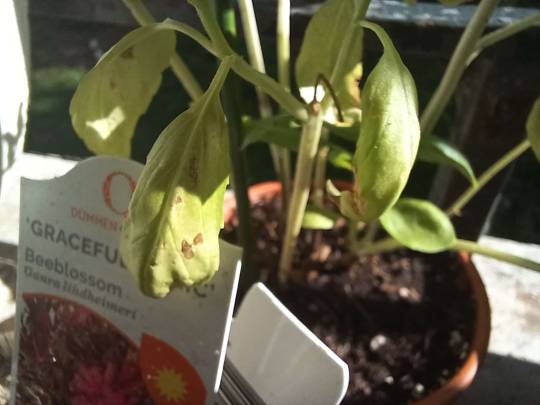
Spotted lanternflies are vulnerable to neem oil (So are brown marmorated stinkbugs btw), tea tree oil, and peppermint oil. I mean to purchase whichever one is harmless to my other plants to spray the lanternflies with to kill them. They're also wildly attracted to milkweed, but it's actually toxic to them, so management strategies for spotted lanternflies often suggest planting milkweed on your property so that they will drink the sap and then die.
I intend to, once I am not struggling to pay bills, purchase a native milkweed plant and stick it allll the way on the end of the balcony AWAY from my other plants in order to draw the lanternflies away and hopefully kill them.
I'm not looking forward to cleaning up the bodies. In fact, a couple minutes before taking the above photo I actually leaned over to take a pic of another one and got a dead one in my hair. I was mortified when I sat up and realized. I'm really, really, really going to hate it when they start reaching maturity, because mature spotted lanternflies are HUGE. They're like 2 inches long, 1 inch wide, and fat-looking. I saw one smeared on the pavement last fall and wanted to throw up. I don't know if I have the strength to kill them myself, which is why I'm hoping neem oil spray and milkweed will kill them for me without having to deal with smashed moth remains,
Here are the life stages of spotted lanternfly, map of their invaded areas, and pictures of the Tree of Heaven for your information to kill/manage them <3
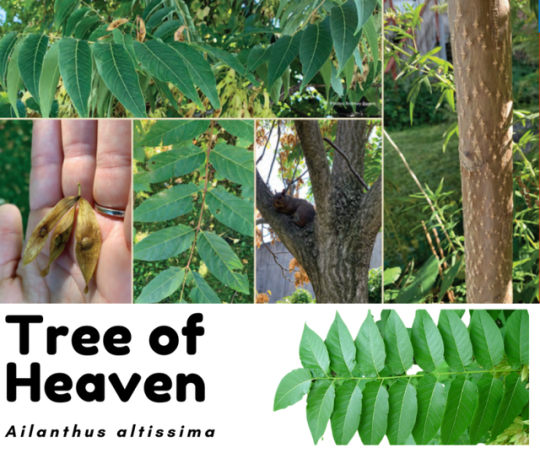
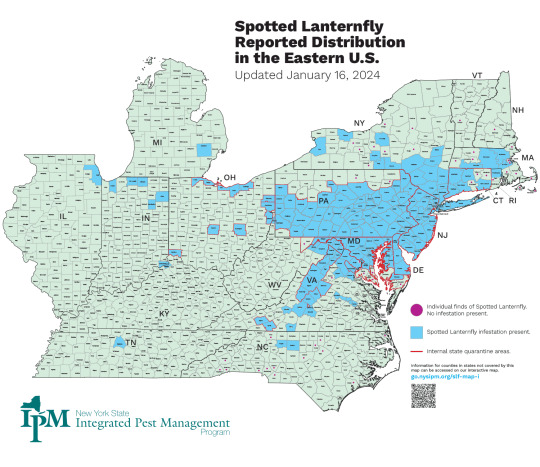
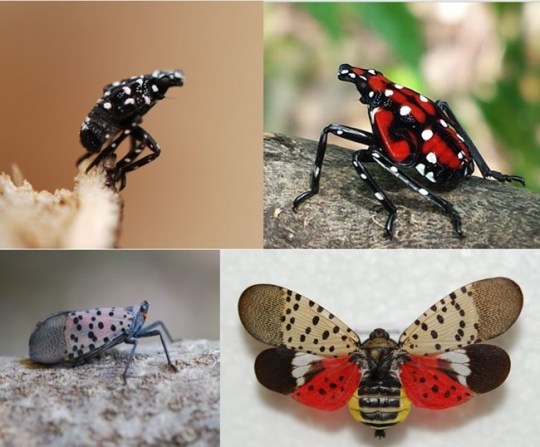
PEsTS aside, I have really good news! My wildflowers have all sprouted!!!!!!
Looking back, I wish I'd verified whether they were native or not. I hope I don't poison the landscape when they go to seed. Once they start flowering, I'll try to identify any invasive or harmful species and weed them out, I suppose.
They first started showing green on a day when i was feeling especially depressed about my recent breakup, so it was HUGE mood boost. It honestly felt like God was like "Yeah ya'll it's time to go green. Right now go go go go go!!"
Don't mind the plant water stakes, they're empty I just don't have a great place to put them right now. I intend to keep them only so I can use them when I go out of town for a few days at a time, so that I don't need to ask my roommates to water my basil daily, or whatever. The first two pictures I took when I first noticed the seedlings, and the third one is from today, along with most of the other photos.
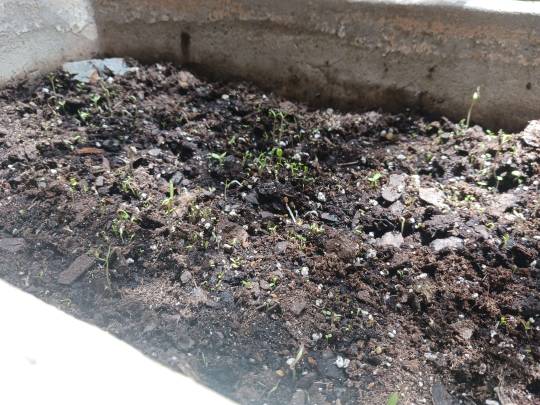
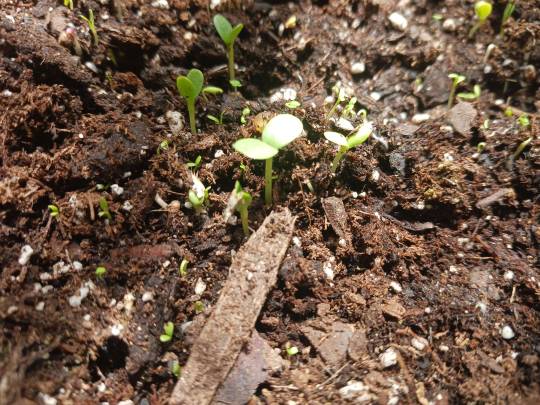
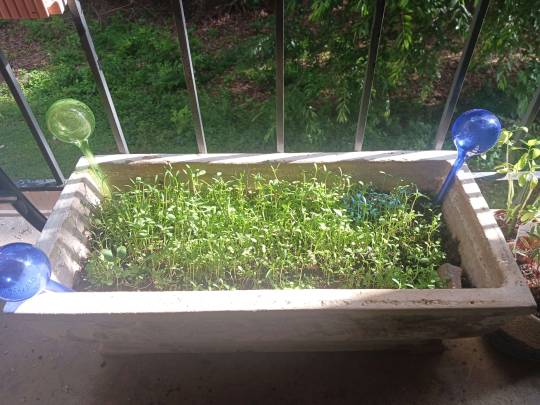
One thing that I am concerned about is that I'm noticing these little banana-shaped things (pods? eggs? seeds?) that look like they've been clamped/clipped onto the leaves of many of the wildflower seedlings, especially the ones on the left end of the planter. They almost look like hairclips that have been shut onto the leaves? I'm really confused. They're pretty dry looking, and my friend James broke one apart and it just kinda disintegrated. (I was too wigged out to touch it) They can't have been there very long, a couple days before I noticed at least.
If anyone has ANY idea what these are, I'd really appreciate it. I'm worried that they're bug eggs. I really hate interacting with/looking at bugs, especially bug eggs, so I tried looking it up myself and had to stop because uhh... pictures of bug eggs. But they definitely don't look like part of the plant, especially since this planter is a mixture of different species and they're showing up on multiple types.
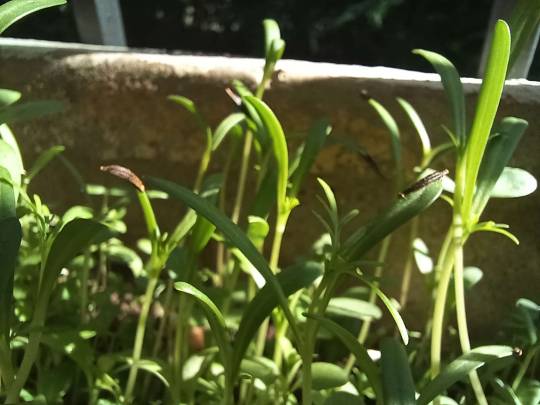
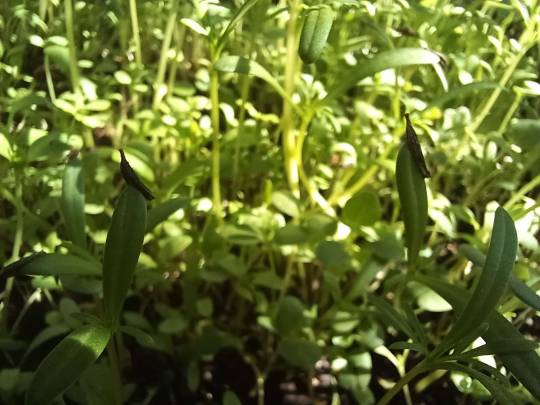
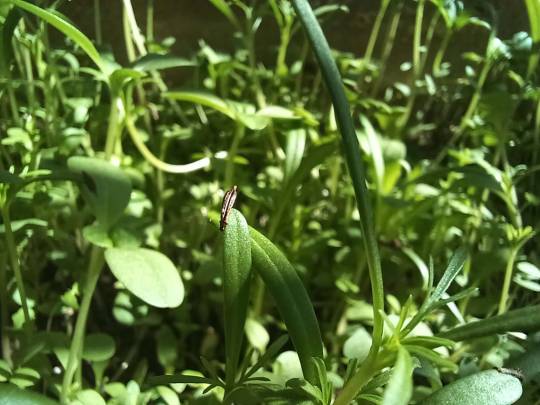
The beeblossom, which I've learned is also called a Whirling Butterflies or a Wand Flower much more commonly than it's called a beeblossom, is doing quite well! The leaves and stems have shifted completely from red to green, and it's showing signs that it might possibly flower for a second time. I really hope it does, the flowers last time only lasted a couple days and I don't remember if I got any good pictures but they were really pretty. I've repotted it into a neat woven-basket pot that I got at the local garden center (This garden center has a cat mascot! That lives at the store! I love him. He let me pet him.)
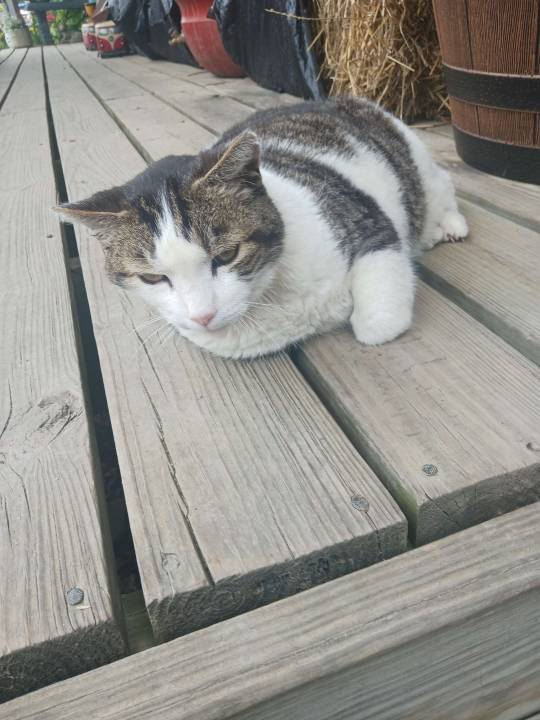
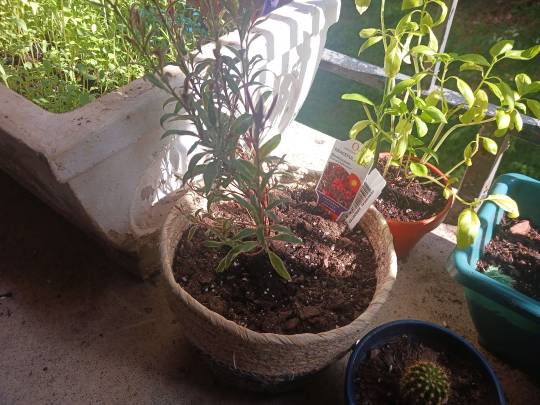

The lavender also went into a similar pot, to get it out of the rice pot that it was in before. Also at this garden center I found a catnip plant!!!! Rookie has been loving it whenever I give him a leaf, but surprisingly I don't think he's figured out the source plant because he doesn't go up to it and sniff it at all. I think he's more interested by the finches, cardinals, and robins that have (finally) found our birdfeeder. To give you an idea of how much the birds have been vibing, this feeder was full to the top only a week ago.
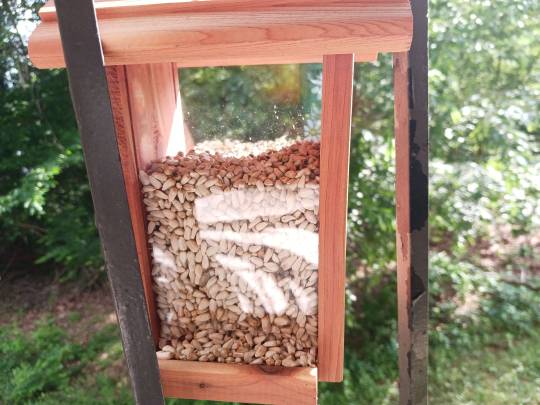
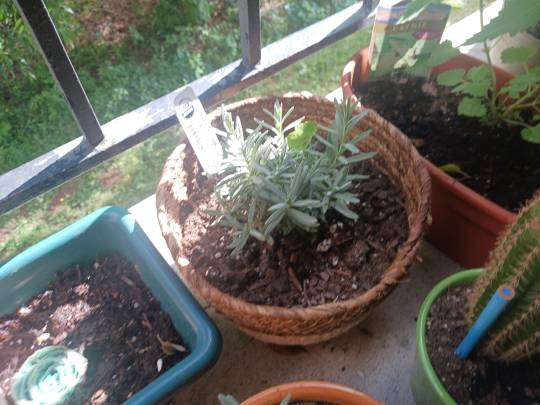
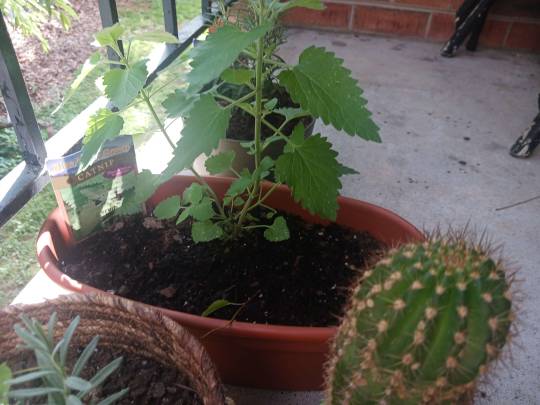
The Echinopsis babies are doing OK. Echinopsis generally do a terrible job of communicating how they are doing. They don't seem to be especially active in growing? Neither the babies nor the parent. I suspect know I repotted the parent into too-small of a pot, so I hope to remedy that at the next opportunity. Just.... large pots take up so much space!!! And they're much more expensive than small pots, especially since I'm so averse to plastic containers due to issues with overwatering plants in plastic containers.
The Echinopsis babies haven't been drinking as much as I'd like, but they HAVE been drinking, which is a sign that the roots are functioning just fine. They were each able to take a root or two from the parent when I propogated them about a month ago, so it's good to know that they're doing alright down under the soil. I'm thinking about selling each of them for $35, with the hand-painted pot, but I hate to part with them. I get so emotionally attached.
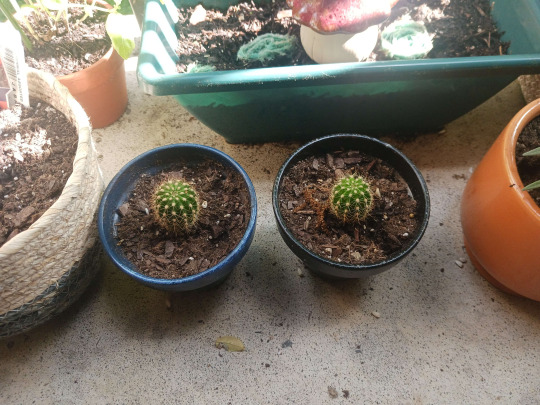
The Thyme, on the other hand, has shown ZERO signs of growth and it's been 12 days. I know they have a long germination time but between their complete silence and the fact that I planted them in the wrong soil (I should have used sandy loam but it's just Miracle Gro) and the soil has been wetter than a jellyfish since I planted, AND they're just from a dollar tree Herb Rocket, I'm starting to become suspicious that they're duds. I'll keep watering and watching them until after I hit the 28 days, but I'm definitely not feeling great about the thyme.
The herb rocket was supposed to be planted as just one roll, also, but because I was using a long container I took some scissors and just cut the rolled up seed tape in half lengthwise before rerolling and planting. The directions were also ambiguous as to whether I was supposed to leave the top of the rolls visible, level with the soil, or to cover them up with the 1/4 inch soil that I've begun to notice is typical of planting instructions.
The left roll you can see is a little bit messed up, because the other day in a fit of disappointment I pulled it out of the dirt and unrolled it to check for anything, ANYTHING, ANY!!! SIGNS OF GROWTH! I found nothing. But that, not before, is the point when I googled the germination time of thyme, then I felt like an idiot and did my best to stuff it back into the soaking wet soil.
God help me with this plant.
My roommate pulled out a little mushroom decoration (she loves mushrooms) for the garden, initially intended to go in the wildflower planter. It was there for about an hour before I took it out, because I didn't want it to kill any of the wildflower growth. Instead I put it between the two thyme rockets. Hopefully, when (if?) the thyme actually starts growing, it will look like there's a little mushroom home nestled between the two shrubs.

Another plant whose performance I am currently dissatisfied with is the African Violet. It's wilting again. At this point it's like, "What am I doing wrong now?" What makes it even worse is that this is the only plant that was given to me as like a, "nurture this plant as a metaphor for nurturing your spirit!" so it's even more depressing that I'm having difficulty keeping it alive. I feel like this plant's survival is tied to my success as a human being (Not really, but that's the vibe).
The leaves are just totally limp. Not really mushy, but I could see them getting that way if it weren't for the fact that they usually just dry up and wither away first. The soil is very wet, which I don't understand because I've been doing my best not to overwater it and it's been a week since it's last douse. The leaves have lost their yellow tinge from overwatering, but only on the topside. The bottomside of the leaves still look brownish, as if they're dried up (except that they arent) If there are any African Violet experts in the crowd, I would LOVE for you to lend me any advice you can give me from the picture <3 I love you.
I've been pruning off dead sections and kept it indoors with a stable temperature in a spot where it gets plenty of indirect light, so I don't understand what the issue is. I'm beginning to blame plastic containers for all of my problems due to all of my Problem Plants being in plastic. (Spider Plant momma, new baby Spider Plant, African Violet, Thyme, Basil in the early months, Beeblossom, probably the catnip soon too).
I desperately want to move all my plastic planted plants to ceramic/terracotta or woven containers, but the issue is just that plastic is the cheapest material for planters, and since I've been upsizing, I genuinely do not have the budget for terracotta right now. Maybe in 2 months, but by then the Basil & Echinopsis will already have had their growth stifled, the Thyme will be drowned, and the African Violet will be well and truly dead.
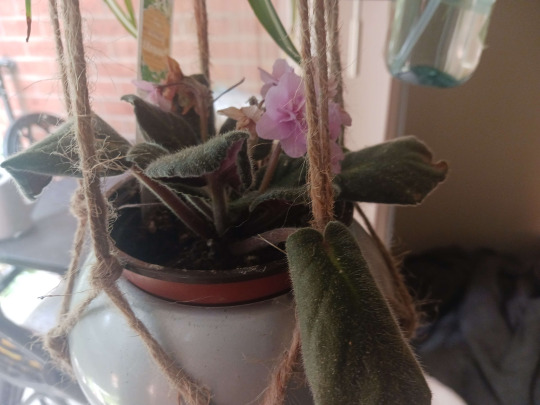
I wasn't able to get any good pictures of the snake plants in this lighting, but they are doing alright also. Their roots haven't quite put down in the new soil, but I think they're kind of growing anyways??? I dunno.
Finally, here is a photo of the Potted Plant Empire as it is today, excepting the indoor plants and the wildflower planter being cut off:
That little pot at the end is my roommate's rosemary, and the orange glass pot is her lavender. Mine is in the woven basket next to it.
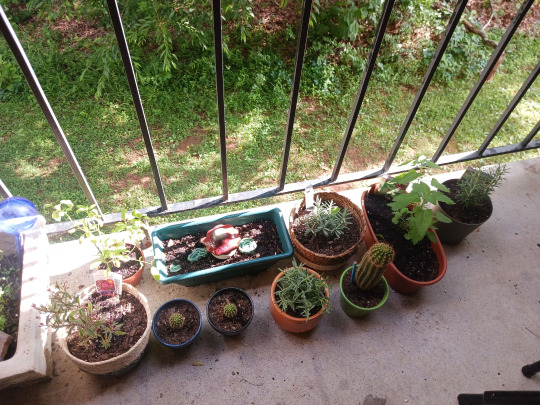
I feel like that guy in the recent Drive Time app advertisement. "I FEEL STRONGG!!!"

#gardenblr#garden post#potted plant#spider plant#african violet#african violets#echinopsis#cactus#cacti#succulents and cacti#lavender#wildflowers#basil#thyme#garden diary#journal#gardening#plants#plant help#garden help#its the drive time real deal maker#wand flower#beeblossom#apartment life#balcony garen#air plants#bug mention#bug pictures
12 notes
·
View notes
Text
Now I want to elaborate on the Makuta of Odina as our big bad villain. The thing about Vamprah is that he’s a hunter, and one who has taken a vow of silence; He acts animalistic, all things considered, and wears the Mask of Hunger, which adds to his motif as a predator who feasts on prey.
One of the earliest descriptions of Makuta was that of a “raging, kicking, screaming beast” and it’s a depiction that’s really stuck with me. Less of a person or god and more of a monster, an animalistic force of nature incomprehensible to the Matoran.
When Makuta was first introduced, it was as the master of the Rahi, powerful and dangerous beasts that have been placed under his sway by masks he infected. This precedent was not forgotten later down the line, when 2003 established Rahi Control as one of Makuta’s powers, and it was eventually revealed that the Brotherhood of Makuta’s original purpose was to create Rahi for the Matoran Universe.
So Makuta in this story is the apex predator, the leader of a pack; The most powerful beast in the land, for whom all others answer to. And an unnatural, ravaging monster with endless hunger, and a taste for sport. There’s a sadistic side to Makuta, who ravages ecosystems like an invasive species.
Humanity has a primordial fear of beasts lurking in the darkness, waiting to strike; Unseen with only our imaginations to fill in the gaps. So let’s incorporate that idea for the Makuta of Odina; A creature who brings darkness with it, enveloping the area in shadows for Makuta to hide in and strike unseen. Like Shelob from Lord of the Rings, and especially like...
You ever heard of Genndy Tartakovsky’s Primal? It’s a wonderful animated show, about a caveman and his T-rex surviving against some horrible odds in prehistoric times. My favorite episode is the The Night Feeder, and the titular beast is a cryptid that strikes only at night, in total darkness. It remains entirely unseen for the whole episode, so you can only see from its perspective, and glimpse the damage it inflicts on prey and environment alike.
We only get to see the Night Feeder’s dreaded true form in the last minute of the episode, for a few seconds. This is after our protagonists learn that its fear and weakness is fire; Fire which brings light, which allowed humanity’s ancestors to conquer the darkness and explore new horizons. The Night Feeder is beaten as it is seen and revealed, stripping it of the infinity of the unknown by making it quantifiable via comprehension.
I want to play with that idea; A thematically protean creature that can be anything, whatever its prey imagines, because it’s a Schrodinger’s Cat situation where if you can’t see it, who knows what it is? And thus so many options are on the table. Makuta is a monster of shadows, so the way to defeat it is with light; Light thematically reveals its true form, taking away both the shadows it uses to hide itself, but also taking away a lot of the mystique and fear Makuta employs. It is no longer a formless entity, you can see now that it’s limited to the physical form that is illuminated. Like Jean Jacket from Nope, seeing the beast is a form of victory over it.
And it’s neat that I bring up the idea of monsters and beasts that must be hunted, primordial times and whatnot. Because Vamprah’s domain in G1 is the very headquarters of the Dark Hunters... So what if we took that name literally in this adaptation? You’ve got this mercenary group, not exactly good guys, but our protagonists hired against an even greater threat. Makuta ravages livestock, it slaughters entire herds for no other reason than the fun of it, while eating something unknown from its prey that cannot be interacted with.
Enter our Dark Hunters; A group of trophy hunters, monster hunters, that kind of thing. They’ve conquered the most elusive and dangerous cryptids, but this is their greatest hunt yet. They learn the mistake of underestimating the Makuta; They think they’re the masters of the shadow? The Dark Hunters believe it’s their territory and camouflage from which to strike? Their greatest asset has now been turned against them by the Makuta.
Our protagonists can be Dark Hunters with explicit ties to hunting and/or animals; Such as Airwatcher, Savage, Charger, etc. Tracker and his pet bull are must-haves, as is Primal, whose name and use of a simple spear feels VERY relevant given the influences I’m incorporating into Makuta here. The Hordika Dragons can be a pack of hunting dogs, feared and reputable, only to fall against the Makuta.
There’s definitely the tension of Man VS Nature, Man trying to conquer the wilderness and its animals, taking trophies. Maybe Makuta is a punishment sent upon these Dark Hunters, who kill for sport, and now find themselves on the receiving end of a karmic beast who inflicts the same. It eats light, spreading the night and darkness across Odina, thereby spreading the Makuta’s territory. It can only strike in shadows, but when it does, it’s virtually unstoppable. Courage is tasty and Makuta knows its scent, devouring bravery to leave nothing left of its prey but terror in their souls as they are shredded.
While other Dark Hunters rely on fancy tools and machines that fail in the face of the supernatural power of Makuta, Primal (whom I shall refer to by the name Nuoka given by creator Peter Dolan), our main protagonist, prevails in his simpler toolset; He hearkens back to the ancient hunters of prehistoric times who fought like animals and thus better understood them. He can fight on Makuta’s level, by Makuta’s rules, and actually make it out alive. Firedracax is another hunter with a specific grudge against a species of pack predators, whose whole power is fire; This could thematically put him at odds against Makuta as another main protagonist.
There can be some discussions of industrialism vs nature, the idea that perhaps a society more removed from it isn’t necessarily better. Cities aren’t necessarily more ‘advanced’ than a nomadic society, after all. This ties into Nuoka as a former member of a tribe, who has his own defense against the prejudices of other Dark Hunters. Likewise, civilization may not be as divorced from nature as it likes to think; Society is still a part of nature and thus has a responsibility to it.
Makuta is a challenge to human arrogance; Not literal human arrogance, these characters aren’t human. But you get what I mean. The shadows have birthed a dark creature, like the Grendel that Beowulf fought, or many other beasts sent by the gods and/or nature to punish humanity’s hubris. Makuta is the Scorpio to the Dark Hunters’ Orion. Maybe Makuta was once a hunter named Vamprah, who was cursed for his bloodlust with a form that reflected his heart, and even infects others with this transformation to create Rahi.
I like to think the Makuta of Odina resembles the Makuta Nui set from G1; A more animalistic take on Makuta that never showed up in the story but was nevertheless deemed canon. It looked bestial enough that for the Maze of Shadows game, the developers even declared it the set depiction of the Ash Bear! This can be Makuta’s true form, revealed in its final moments when light finally triumphs over its darkness, just as Nuoka manages to slay it. This beast spoken of around campfires is now just a campfire story.
I also want to consider incorporating the Rahkshi here as Makuta’s brood; Creatures who wield staffs resembling man catchers, which is a karmic reversal of man trapping beast. The Makuta Nui combiner takes some visual cues from the Rahkshi, since it’s made using pieces from Makuta; Himself resembling his ‘sons’ and vice-versa. So the Makuta of Odina can resemble a more animalistic, bestial Rahkshi, foregoing a tool for massive claws and fangs. Makuta’s visage takes cues from from the Avsa, Kraahkan, Makuta Nui, and Rahkshi.
In darkness, Makuta stalks and hunts its prey across multiple environments, apparently flying and swimming; Suggesting it DOES shapeshift, or maybe it just comes across that way in the confusion and chaos of the dark. Survivors disagree on what they saw of Makuta, who can say for sure? Other Rahi act as smaller bosses for our protagonists to build up through, and maybe reconsider their treatment of beasts, at least for Nuoka. When Makuta is slain, there’s definitely the implication that Nuoka has been motivated by his experiences to bring a change to how the Dark Hunters operate in irreverence to nature, and if necessary, stop them altogether.
28 notes
·
View notes
Text

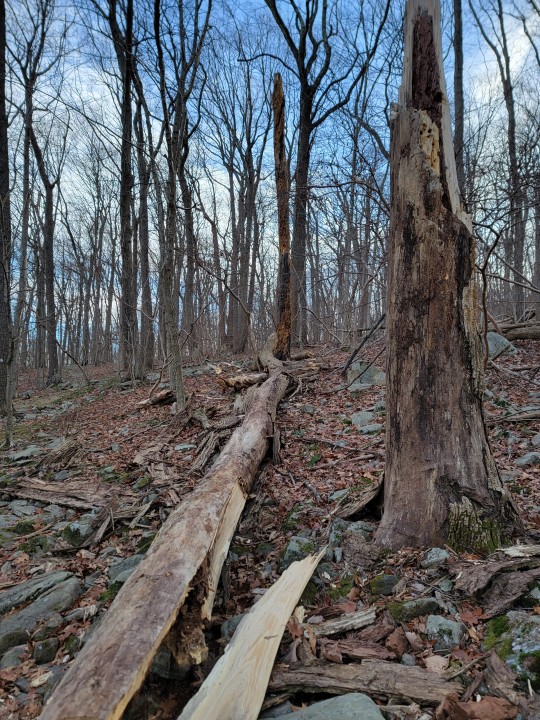


White Ash - Fraxinus pensylvanica
For this post I'm going to discuss the snags and reason I got back into ecology: The Ash Tree
Around the 1990s an insect from northeastern Asia was accidentally introduced to the Continental United States, by 2002 this insect was identified in Michigan after destroying several million acres of forest, this insect was the Emerald Ash Borer. The borer's larvae consume the living inner bark layer (leaving an interesting pattern), ultimately starving the tree of nutrients. The bark will often flake or peel off. By the year 2015, there were signs that the borer had spread to the east coast, its journey likely accelerated by the spread of firewood from infected logs, by 2019 nearly every mature Ash tree in Northern New Jersey was killed.
I grew up in a yard with twelve 150 year old Ash trees, the yard was adjacent to a section of Ash dominant forest, I watched the slow decline of all these trees, for half a decade I hoped our trees would be lucky enough to survive but unfortunately they all died within a few summers. Although the White Ash trees I encountered were wild from a 20th century clear-cut, they were a fairly common street tree around the northeast, straight growing, lovely bark and unfortunately most of the nursery stock was derived from a similar gene pool. There was little genetic diversity and many suburban neighborhoods were wiped of Ash trees. Many Ash trees were infested and look like the section of log I saved from my yard now (image below)
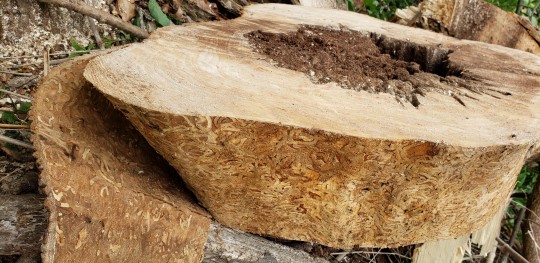
Suburban yards aside I quickly began to notice entire sections of forest filled with standing deadwood (image below). Worse yet white ash wasn't the only ash species affected, the entire genus is at risk. American Ash species often occupy a unique niche in cultivating young organisms which grow in vernal pools, the leaves of american ash are low in tannin, meaning they're one of the few leaves which are a suitable food source for young frog tadpoles. The loss of the ash means damage to American frog populations. It also means insects which utilized ash as a host are also at risk.
Ash also has quite a lovely ethnobotanical history, black ash is famous amoung various tribes around the northeast for its use in basket weaving. Historically Lenape elders would use the juice from white ash leaves for reducing swelling. More modern settler usages revolve around using the elastic yet study wood for baseball bats, oars, hockey sticks, and tool handles. My friends father used to raid his boss's construction sites at night to harvest ash slated for removal and deliver it to a baseball bat manufacturer for a decent payout. Ash also has a lovely grain visible in the broken log in the second image
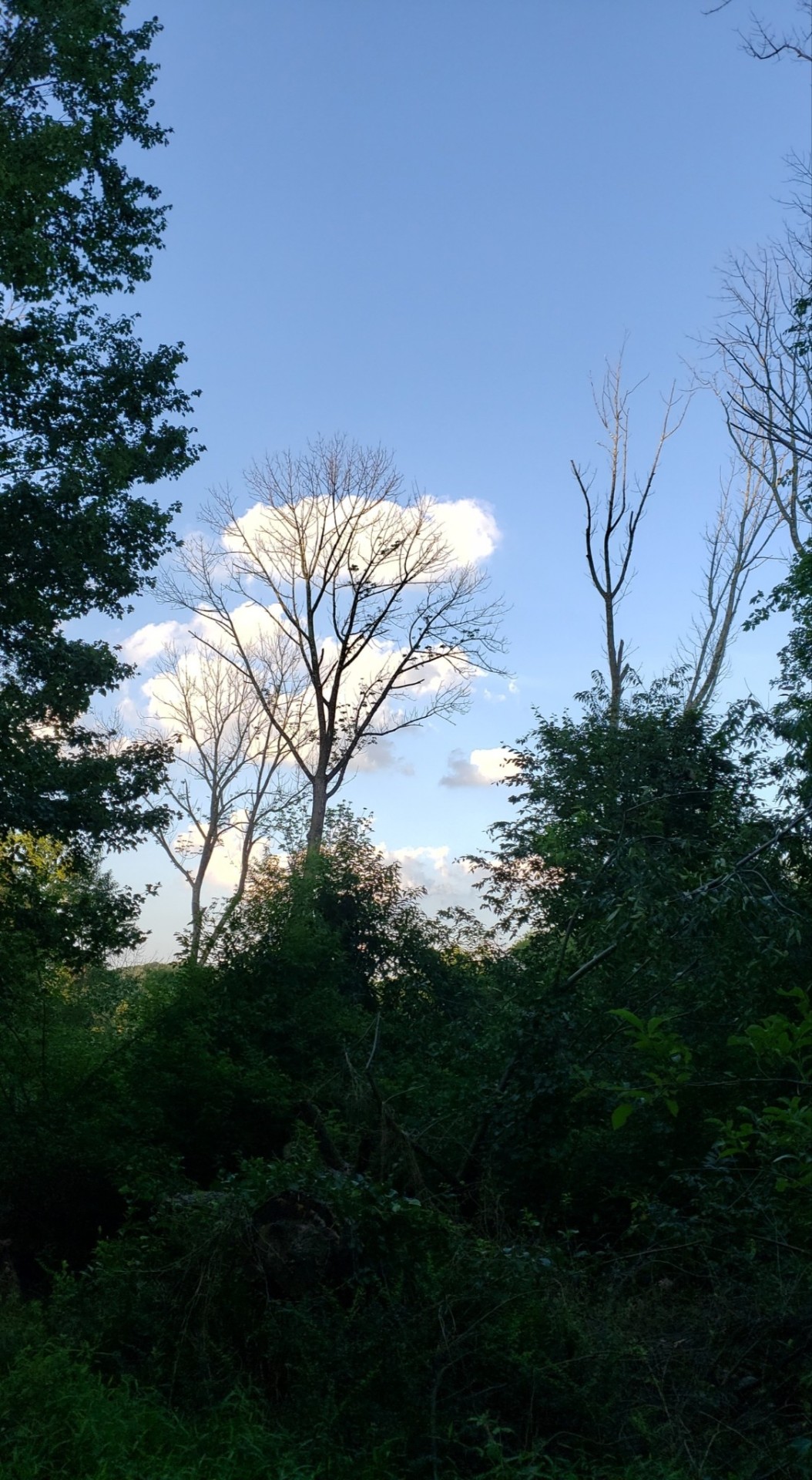
Ash forests now eerie snag filled openings which creak and occasionally fall on unsuspecting hikers. The thought of watching an entire forest ecosystem go really bothered me, ash swamps are unique, varied, there's something almost indescribable about growing up hearing early spring chirps from little tree frogs at night which are now silent. I left my job in architecture and started pursuing a degree related to landscape architecture and ecological planning (not that this is the answer). I started propagating ash trees where I could and planting them around. Unfortunately ash can't immediately return, invasive species often outcompete ash trees in their former forest, the added pressure ultimately reduces their ability to regenerate. The borer has spread so far there is little we can do to remove it, however there is a positive effect with biological control via the borers' specific parasitic wasp.
Is this the end of the ash? Hopefully not. I still find saplings throughout the woods, ash can be aggressive in the right conditions, can they survive into maturity is another question. Perhaps in another century, more will return, and ash will occupy our woods once more. Like the Chestnut work is being done to breed more resistant species.
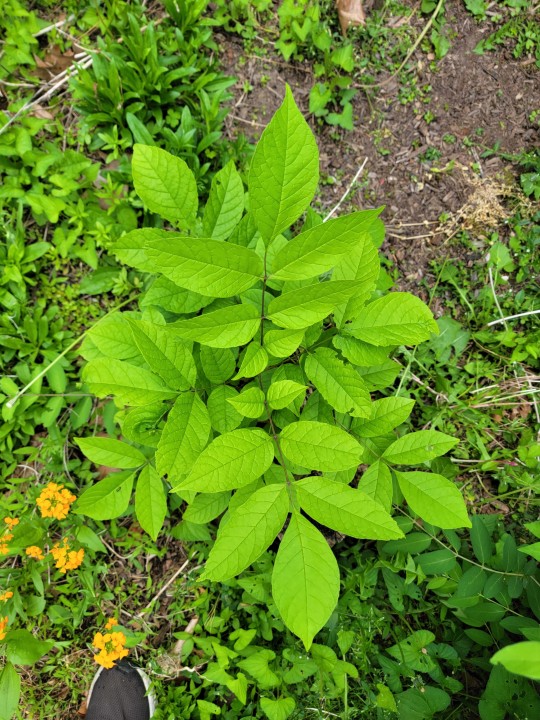
11 notes
·
View notes
Text
Why Hunting Is Good For the Enviroment
disclaimer, this is from a primarily new zealand perspective
goats destroy many native plants. when they eat a plant they usually kill it. wild mammals are extremely threatening to endangered species such as kakabeak, of which only 153 are left in the wild as of current. hunters massively contributed to eradicating these invasive species from mount Taranaki. this means native birds can be reintroduced, such as kiwi, blue ducks/whio, and kōkako, the latter of which may introduce themselves if there are few predators.
the plants often killed by goats, deer and pigs are also home to many lizard species, some of which are only found in Taranaki. a lot of people dont know, but these mammals (particularly deer, which need extra calcium for their antlers, and pigs, which are omnivores not herbivores) eat baby birds if given the chance. Aotearoa's native birds evolved with very few predators, and many nest near the ground where they are easily picked off.
and then theres the possums.
possums may be cute but they are a huge threat to Aotearoa's entire ecosystem. possums eat leaves of native plants and continue eating the new growth, stopping the plant from recovering. they can destroy entire canopies, resulting in forests being turned into low-lying bush. possums are a huge factor in the decline of plant species such as pōhutukawa, rātā and kōhekōhe. they eat eggs, chicks and even adults of kākā, kea, kiwi, kōkako, kererū, tui, fantails, bellbirds and more. every native species of Aotearoa is threatened by possums.
but there is something that can help. areas where possums are controlled have a significantly higher rate of success in nesting birds. hunters can shoot possums and can even sell the skin. possum fur is hollow to trap heat inside the hairs. it is very soft and warm and can be used for boots, coats, blankets, hats, and pretty much anything like that. the leather is soft and flexible but still tough.
around 2-3 decades ago, Aotearoa had approximately 50-70 MILLION possums. now research suggests there is around 30 million possums. compare that to the mere 5.5 million humans here. thats still a lot, but it is a huge improvement.
if it werent for hunters, there would still be goats, pigs and deer destroying the unique enviroment of mount Taranaki. next we need to eradicate possums. a single possum can eat up to 60 endangered carnivorous snails in a single night. we need to protect our native ecosystem. we cant let extreme anthropomorphzation (thinking animals are people) stop us from helping wildlife recover. if we dont do something, species will go extinct. human intervention saved the takahē. it can save more if we do it right. dont let more species die like the huia.
if the forest thrives, the birds thrive. if the birds thrive, the forest thrives.
#aotearoa#new zealand#hunting#possums#marsupial#birds#native species#conservation#animals#ecosystem#biodiversity#anarchism#anarchy#anarchocommunism#eco anarchy#eco anarchism#goat#deer
7 notes
·
View notes